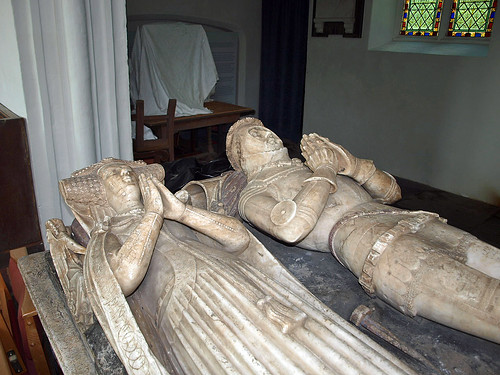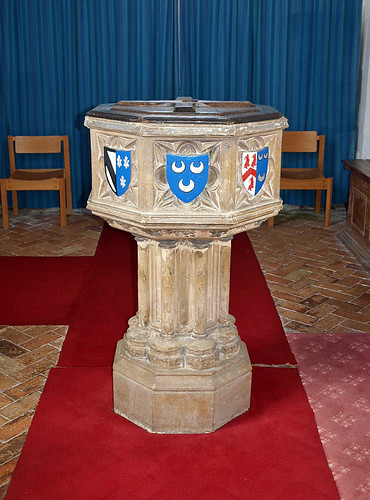ALL SAINTS. W tower of the late C13, see e.g. the W window with its tracery. The battlements with brick and flint chequerwork are of course later. Early C14 chancel, see especially the entertaining E window, which has normal cusped intersected tracery but suddenly, at the top, a tiny ogee arch to house the top quatrefoil. Perp the very tall nave S windows and the S porch, except for its repaired top which, with its heavy segmental gable of brick, looks c.1700. The date of the N chapel is hard to guess. The arch towards the chancel looks Perp, but the N window may well be a Victorian contribution. The E window certainly is Late Perp. All this matters, because between the chancel and the chapel stands the Thorpe MONUMENT, and this is in all probability to Sir Edmund, who died in 1417. The architectural evidence fits that date anyway. The monument is a very fine piece of the alabasterer’s craft. Tombchest with erect young angels holding shields. On the chest the two effigies, well carved, she with angels by her pillow, he with his head on his helmet, and both with dogs by their feet. - FONT. Octagonal, with shields on barbed quatrefoiled fields. The carving is hard, the date surprising: 1660. - SCREEN. Base only, with unusual tracery, repeating the motif of the four-petalled flower in the spandrels. - CHEST. Italian; C17. Of pokerwork. With soldiers, a tent, a town - a martial piece. - PLATE. A complete set of 1670-1, made in London.
ASHWELLTHORPE. It has cottages and farms with cream and rose-coloured walls, a quaint little church climbing from east to west by the wayside green, and a fine Elizabethan hall, now modernised and looking out on terraced lawns.
The great house was the home of the Knyvets, many of whom lie in the church. Sir Thomas, to whom a long ballad was composed in his day, gave the house a name for hospitality in the 16th century, a reputation upheld by Edmund Knyvet’s wife, Jane Bourchier, for we read on her brass* inscription:
Twenty years and three a widow's life she led,
Always keeping house where rich and poor were fed.
A treasure of the church is the handsome alabaster tomb with the fine figures of Edmund de Thorpe and his wife, perfect except that it is marred by the initials of many louts. Sir Edmund, who fought with Henry the Fifth, is in armour and wears a jewelled belt, the Lancastrian collar, spiked gauntlets, and a wreathed helmet. His head rests on a crown and a sheaf of peacock feathers, and there is a dog at his feet. His lady’s lovely netted headdress is crowned by a wreath of jewels and foliage with a dainty eagle crest, and two other eagles form the clasps of her graceful mantle, one of two small dogs at her feet holding its folds. Two angels hold her cushion. Like her husband, she wears the SS collar, a very rare thing for a lady.
The lofty and compact church in which they lie has a 15th-century nave lit by great windows between a 14th-century chancel and a 14th-century tower. On the walls is a medieval mass dial. The porch, with its upper room, is as old as the nave, and shelters an old doorway with its original studded door and a massive ring. There is an ancient coffin stone in the sanctuary, and one of several piscinas is in the corner of a window splay. An old chest is patterned with figures and scenes, tents by a city, ships, and merchandise.
The great house was the home of the Knyvets, many of whom lie in the church. Sir Thomas, to whom a long ballad was composed in his day, gave the house a name for hospitality in the 16th century, a reputation upheld by Edmund Knyvet’s wife, Jane Bourchier, for we read on her brass* inscription:
Twenty years and three a widow's life she led,
Always keeping house where rich and poor were fed.
A treasure of the church is the handsome alabaster tomb with the fine figures of Edmund de Thorpe and his wife, perfect except that it is marred by the initials of many louts. Sir Edmund, who fought with Henry the Fifth, is in armour and wears a jewelled belt, the Lancastrian collar, spiked gauntlets, and a wreathed helmet. His head rests on a crown and a sheaf of peacock feathers, and there is a dog at his feet. His lady’s lovely netted headdress is crowned by a wreath of jewels and foliage with a dainty eagle crest, and two other eagles form the clasps of her graceful mantle, one of two small dogs at her feet holding its folds. Two angels hold her cushion. Like her husband, she wears the SS collar, a very rare thing for a lady.
The lofty and compact church in which they lie has a 15th-century nave lit by great windows between a 14th-century chancel and a 14th-century tower. On the walls is a medieval mass dial. The porch, with its upper room, is as old as the nave, and shelters an old doorway with its original studded door and a massive ring. There is an ancient coffin stone in the sanctuary, and one of several piscinas is in the corner of a window splay. An old chest is patterned with figures and scenes, tents by a city, ships, and merchandise.
* I saw no sign of this brass.



No comments:
Post a Comment